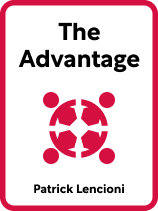

This article is an excerpt from the Shortform book guide to "The Advantage" by Patrick Lencioni. Shortform has the world's best summaries and analyses of books you should be reading.
Like this article? Sign up for a free trial here.
Why are company principles important? What is the key to establishing organizational standards?
A company culture with consistent goals and standards is important for any business. To achieve this, Patrick Lencioni in The Advantage says you must carry out four principles.
To learn about these essential company principles, keep reading.
Establish Clear and Consistent Organizational Goals and Standards
Lencioni says that leadership teams must create a company culture with clear and consistent organizational goals and standards. These goals and standards will provide employees with clarity on the organization’s purpose and their role in it and will unify them through shared values and ideals.
To create a company culture with clear and consistent goals and standards, Lencioni says the leadership team must establish four company principles: the organization’s core purpose, its behavioral values, its strategies for success, and its top priority.
(Shortform note: In The Culture Code, Daniel Coyle similarly emphasizes the importance of a strong company culture with clear and consistent goals and standards. However, rather than the organization’s purpose being one component of a strong organizational culture, he says purpose is the foundation of other cultural elements, like behavioral values, success strategies, and priorities. He elaborates that putting purpose at the core of the organization will increase the energy employees put towards tasks, make people learn faster, and increase connection and empathy among coworkers and customers. Ultimately, these benefits will maximize the organization’s success.)
Principle #1: The Organization’s Core Purpose
Lencioni says that all organizations function to help people in some way. To determine your organization’s core purpose, reflect on what your organization does and why. Your what should be pretty straightforward, but your why will probably be somewhat unique—who are you trying to benefit and how? The possibilities are endless, but your answer must be specific, true, and concise.
For example, if you run a dry cleaning business, your what would be “we wash and dry people’s laundry.” Your why could be “we wash and dry people’s laundry so that clean, professional-looking clothes are accessible to all.”
(Shortform note: In Find Your Why, Simon Sinek agrees with Lencioni that your purpose statement must be specific, true, and concise. However, he emphasizes one more characteristic that Lencioni doesn’t mention: Your purpose statement must be constant. This means that your purpose should be upheld in all aspects of your work and should endure over time. For example, if your core purpose is to help people save money on essentials, you can uphold this purpose by providing employees with free hygiene essentials like toothbrushes and deodorant.)
Principle #2: Behavioral Values
Lencioni explains that healthy organizations must identify their behavioral values so employees align with and uphold the company’s cultural expectations. These values should encompass (1) positive behaviors that are already represented in your organization and (2) behaviors that you aspire to incorporate into your organizational culture. When compiling your list, Lencioni recommends writing these values as they would look in action rather than as one-word adjectives—this makes them more specific and actionable for employees.
For example, avoid one-word values like charity, altruism, and drive. Instead, say “a passion for helping those who are less fortunate,” “willingness to sacrifice personal wants for others’ needs,” and “tenacity to accomplish personal and professional goals.”
Principle #3: Success Strategies
Lencioni explains that another company principle healthy organizations should have are three primary strategies that they use to achieve their core purpose. To identify these strategies, brainstorm a long list of all the possible ways that you can achieve your purpose. Then, divide similarly themed ideas from your long list into groups and label each theme—for example, ideas that are related to keeping consumer costs low can be lumped into an “affordability”-themed group. Finally, narrow down the three themes you think are most important to upholding your core purpose—these will be your primary success strategies.
Lencioni says that this method will ensure that your company’s actions align with and progress your core purpose. This will result in organizational clarity and consistency, two factors that are vital for healthy organizations.
For example, imagine your dry cleaning business’s core purpose is to “wash and dry people’s laundry so that clean, professional-looking clothes are accessible to all.” Some strategies on your long list might be: Keep prices low, use hypoallergenic detergent, be located within walking distance of public transportation, and remain open 24 hours a day. These strategies can be lumped into the overarching theme of “inclusivity,” which is an important strategy for upholding your core purpose.
Principle #4: The Short-Term Goal
The last company principle every business should have is a single, short-term goal that’s their top priority. This will ensure that the organization solves issues that could harm it and continues to improve. Your short-term goal should be achievable within three to 12 months and should be a shared effort among the leadership team.
To determine your short-term goal, consider one thing that must be done in the next year or less to improve or maintain your organization. Then, create a to-do list—determine exactly what must happen to solve the problem or achieve the goal. Finally, determine the areas of improvement your organization must focus on to accomplish each item on your to-do list.
(Shortform note: In Traction, Gino Wickman also emphasizes the importance of short-term goals, but his recommendations slightly differ from Lencioni’s. While Lencioni recommends creating goals that can be accomplished in three to 12 months, Wickman says that you should give yourself a full 12 months to complete your plan. The plan must include a revenue goal, a profit goal, and measurables (like a number of clients to gain or a number of products to produce). You must also identify seven priorities you’ll complete within the year to propel you toward the goal—a more specific version of Lencioni’s to-do list. Finally, Wickman recommends creating a budget to ensure you have the necessary resources to complete the plan—something Lencioni doesn’t address.)

———End of Preview———
Like what you just read? Read the rest of the world's best book summary and analysis of Patrick Lencioni's "The Advantage" at Shortform.
Here's what you'll find in our full The Advantage summary:
- How the biggest business advantage you can gain is free and within your reach
- How to create an effective leadership team
- How to maintain organizational health with effective meetings






